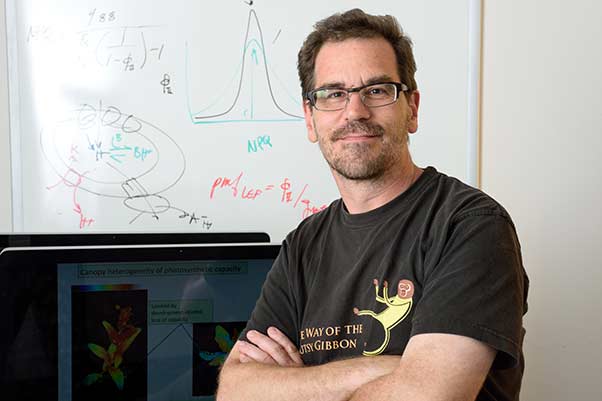This article has been reposted from the MSU-DOE Plant Research Laboratory
By Igor Houwat, Jingcheng Huang, David Kramer, Danny Ducat
In one video, you see a dark, opaque surface, pulsating slowly. All of a sudden, a flash of light streaks across the surface with the intensity of a lightning bolt. The light spreads out, lingers brilliantly for a moment, before it melts away.
We are looking at millions of electrons buzzing within an artificial crystal, made of proteins. The electrons randomly hop between a network of electron carriers.
The video is part of a new study, recently published in the Journal of the American Chemical Society, from the labs of David M. Kramer, Hannah Distinguished Professor, and Daniel (Danny) Ducat, associate professor, in the MSU-DOE Plant Research Laboratory. The work explores how electrons can move across long distances within biomaterials, such as proteins.
Electron movement – what scientists call electron transfer – powers many of life’s functions. A good deal of the energy we derive from the foods we eat is captured by a process that removes electrons from food molecules, like sugar or fat, and transfers them to the oxygen we breathe.
Scientists are trying to harvest this ‘electricity from biology’ to power our technologies and produce new products, such as high-value medical compounds and hydrogen gas as a clean fuel source. We have a lot of ability to control electron transfer in metals or semiconductors, for example in batteries. Yet our control over electrons in living, biological systems is more limited. Researchers know a lot about electron transfer over very small distances – say, across tens of atoms. But the process of moving electrons over larger distances – even the length of one cell – remains somewhat of a mystery.
“One common way cells move electrons is to shuttle them around on small protein electron carriers,” Kramer says. “The carriers are ‘docking areas’ that carry the electrons around in a safe way around the cell. But, this method is not very efficient because it is undirected; the electrons move in a random way. Also, if oxygen comes into contact with these proteins, it can hijack the electrons and form toxic reactive oxygen species that can kill the cell.”
These issues have caused scientists to grapple with how to safely target the movement of electrons from one point to another.
CRYSTAL SHEETS MADE OF PROTEINS
In the study, the labs report a new solid-state system that does just that. It consists of billions of biological electron carriers (cytochromes, named for their vivid red colors) arranged in a 3D crystal so that their electron carrying centers (hemes) are nearly in contact with each other. Electrons added into one part of the crystal rapidly hop from one carrier to another, moving across the entire length of the crystal.
The crystals are long and thin, so that the electrons move large distances. The crystals also protect the electrons from encountering oxygen. This feature could make electron transfer safer and more efficient.

The new system mimics that of one found in some bacteria, like Shewanella. These organisms have evolved structures, dubbed “nanowires”, that allow electrons to move over fairly long distances, about as long as a typical bacterial cell. The new crystal “wires” are so much longer in comparison that one can even see them with the naked eye.
The team will use this system to examine the challenges behind long-range electron transfer.
“When a system contains thousands of loose parts, electron transfer is impacted by many factors,” says Jingcheng Huang, a postdoc in both the Kramer and Ducat labs. “The larger the system, the more unpredictable the electron transfer, compared to a single point-to-point jump.”
“Without a physical model to work with, like our crystals, it is hard to extrapolate the dynamics of short jumps onto larger surface areas. Our challenge will be to figure out how to efficiently move electrons over long distances, say microns (thousands of nanometers), which is necessary to create this futuristic microbial cell factory or power generation system” Huang adds.

Kramer adds, “One very beautiful thing about the crystal wires is that we can make videos of the electrons moving. When an electron is on a heme carrier, the carrier changes its color. We can see electrons moving in real time with a simple video camera. This is allowing us to test whether the theory developed for short distance transfer can work over longer distances. In fact, the work suggests that some new, and unexpected, factors may become important in these solid-state systems. This new knowledge is pointing the way towards engineering better wires.”
The long-range game with these crystalline wires is to harness the electricity for useful applications in fields such as bioenergy and disease.
One idea is to connect two kinds of living cells that would be normally incompatible. For example, a cell that stores energy by photosynthesis could ‘wire’ the energy to another cell that uses it to make useful products. The wire link would allow both reactions to safely occur in the same space, since photosynthesis makes oxygen, which is toxic to many organisms.
“Indeed, some scientists think that if we can better understand and control the flow of electrons from living organisms, we could build systems where living cells directly communicate with electronic devices,” adds Ducat. “This idea may be quite a way off yet. But, such bio-hybrid devices could have a range of applications, from medicines to sustainable energy production.”
This work was primarily funded by the US Department of Energy, Office of Basic Energy Sciences. Banner image: One common way cells move electrons is to shuttle them around on small protein electron carriers. This banner image depicts a rendition of electron carrier proteins, with the electron carrying centers in red. By Jingcheng Huang, post-doctoral associate, MSU-DOE Plant Research Laboratory, 2020
